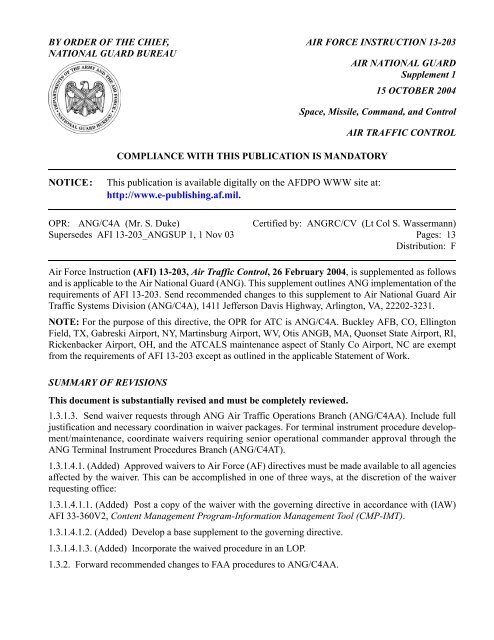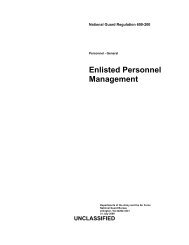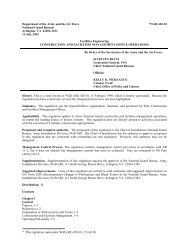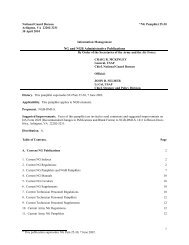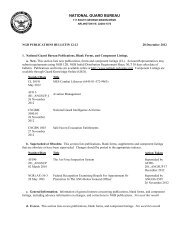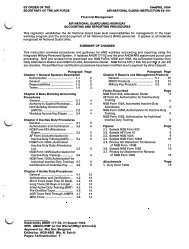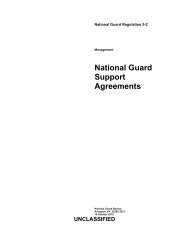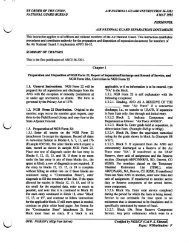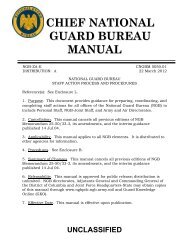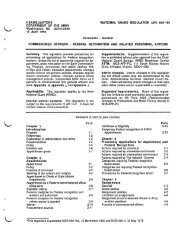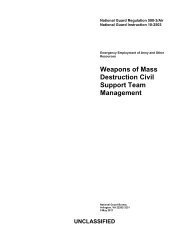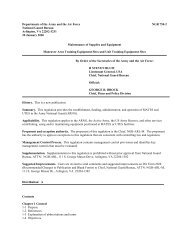(AFI) 13 - NGB Publications and Forms Library
(AFI) 13 - NGB Publications and Forms Library
(AFI) 13 - NGB Publications and Forms Library
Create successful ePaper yourself
Turn your PDF publications into a flip-book with our unique Google optimized e-Paper software.
2 <strong>AFI</strong><strong>13</strong>-203_ANGSUP1 15 OCTOBER 20041.3.3. Forward Special Use Airspace waivers directly to ANG/C4AA, who will coordinate with ANGAirspace <strong>and</strong> Ranges Division (ANG/C4R).1.4. Conflicting Directives. Forward a copy of conflicting ATC directives to ANG/C4AA. Include backgroundinformation on how the directive affects the unit in your cover letter.1.7. ATC <strong>Publications</strong>. Air Traffic Control Squadrons will determine <strong>and</strong> maintain a current list ofessential publications needed to support wartime taskings/theater responsibilities.1.8. Local Operating Procedures (LOP). These LOPs shall arrive, via e-mail, at ANG/C4AA at least30 days prior to proposed implementation. Include ANG/C4AA in distribution of final documents.1.8.4. The use of an airport certification guide containing appropriate requirements fulfills the m<strong>and</strong>atefor a base Airfield Operations Instruction. At joint use/civilian airfields, the local airport certificationguide may contain information vital to airport operations. Local airport managers <strong>and</strong> operational comm<strong>and</strong>ersdetermine use of these documents. Forward airport certification guides serving all or part of thispurpose to ANG/C4AA as part of the coordination process.1.12. (Added) ANG/C4A Web Site. This official site is designed to provide ATCALS personnel with anelectronic source for downloading <strong>and</strong> viewing pertinent information <strong>and</strong> documents. The URL addressfor the site is https://web.ang.af.mil/c4/c4a.2.1. Tower, RAPCON, GCA, Facility Chief Controller (CCTLR). Complex CCTLR assignments willnot be applied to any ANG location.2.1.2.2. Single facility CCTLRs must become facility rated <strong>and</strong> maintain proficiency within six monthsof assignment to the CCTLR position.2.3.1.2. Must be facility-rated, including coordinator positions <strong>and</strong> WS qualifications, in all facilities,before assuming duties, <strong>and</strong> maintain proficiency.2.5.1.1. At locations where the ANG provides ATC services WS/SC must have performed duties in AirForce Specialty Codes 1C1X1/<strong>13</strong>MX for at least four years (not including instructor duty or OfficerTraining Program [OTP]), <strong>and</strong> have one year’s experience in type facility to supervise, excluding RFC.2.5.1.1.1. (Added) “Experience” is defined when a controller completes all training requirements <strong>and</strong> isawarded his/her initial facility rating. The four years experience will be counted (such as DoD, FAA, contract,etc.) in consecutive days provided the controller maintains his/her facility rating.2.5.1.3. CCTLRs document watch supervisor certifications, by facility, on the controllers AF IMT 3622,Air Traffic Control/Weather Certification <strong>and</strong> Rating Record.2.8. Non-UMD Positions. The Air Traffic Manager (ATM) shall ensure all appointments to the followingpositions <strong>and</strong> responsibilities are documented in writing.2.8.3.1.3. ACSE personnel must also be WS certified in the facility they support.2.8.4.1.3. ATSN personnel must also be WS certified in the facility they support.2.9.2. The “PAR function” referenced above refers to RFC as defined in Attachment 1, Terms.2.10.1.1. NOTE : For civilian controllers without a military obligation, FAA medical st<strong>and</strong>ards apply(FAR Part 67 <strong>and</strong> FAAO 3930.3). Where civilian controllers have both a military <strong>and</strong> civilian ATC obligation,civilian medical st<strong>and</strong>ards apply when performing duties in civilian status (Title 5); <strong>AFI</strong> 48-123medical st<strong>and</strong>ards apply when performing duties in military status (Title 10/32).
<strong>AFI</strong><strong>13</strong>-203_ANGSUP1 15 OCTOBER 2004 32.10.2.2.1. (Added) ANG controllers in Title 32 non-military pay status are considered civilians.3.2.1. Each ANG ATC function shall retain all voice recorder tapes/cassette <strong>and</strong> data extraction discrecordings for a minimum of 45 days.3.2.2. Each ANG ATC function where the ATC automation system has the ability to record operations onthe system, shall retain all voice recorder tapes/cassette <strong>and</strong> data extraction disc recordings for a minimumof 45 days.3.2.3. DAT cartridges, cleaning cartridges <strong>and</strong> cassette cleaning cartridges must be stored in a securelocation. Use of the Digital Voice Recorder (DVR) rack drawer is acceptable as long as the drawer issecured at all times when not being accessed <strong>and</strong> the key is secured in a location other than on the rack orin the DVR rack lock.3.3.3. Include pertinent emergency action checklists in position ready reference files, to include the watchsupervisor position. Checklists will be customized to reflect individual position responsibilities. Watchsupervisor checklists will contain information as determined by the CCTLR <strong>and</strong> include as a minimum,facility evacuation procedures, MISHAP/HATR reporting procedures, Readiness, bomb threat, alternatecommunications, <strong>and</strong> explosive detection K-9 teams.3.3.4.1. Off-base crash grid maps are required at tower locations where tower airspace is below the servicingapproach control’s radar coverage or tower operations are conducted outside the approach controlfacilities operational hours. Validate the currency of these maps at least annually, <strong>and</strong> document themethod of validation.3.5.1.1. Facilities operating under the Federal Contract Tower (FCT) Program must submit both FAA <strong>and</strong>USAF traffic count data.3.5.2. Units develop local procedures outlining “special use” category operations. Forward these proceduresto ANG Air Traffic Requirements Branch (ANG/C4AR) for approval prior to implementation.3.6.1. Units shall ensure proposed or planned changes are documented in appropriate forums such as AirfieldOperations Board, ATCALS Review Boards or within the AF IMT 3215, IT/NSS Requirements Document,process.4.5.2.1. (Added) Facilities using FMQ-<strong>13</strong> equipment to provide wind information will issue the wind as“estimated.”4.14. Emergency Frequencies. At locations where tower has override on emergency frequencies, checkthis feature <strong>and</strong> recording quality during emergency frequency checks.4.14.1. ATC facilities shall notify only a single base agency if ARTCC notification is delegated to anotheragency.4.16. Interruptions to ATCALS. The LOP described above shall include response times, PM schedule<strong>and</strong> a restoration priority listing. Where maintenance is performed by the FAA or contract maintenancepersonnel, response times may be driven by organizational or contractual requirements but still requireOG/CC concurrence.4.16.4. (Added) The CCTLR of the ATC facility responsible for NAVAID status, in coordination withChief of Maintenance, shall coordinate with the appropriate local manager on all preventive maintenanceinspections (PMIs) <strong>and</strong> deferments that will create unscheduled NAVAID outages.
4 <strong>AFI</strong><strong>13</strong>-203_ANGSUP1 15 OCTOBER 20044.17.1. At some joint use/civil airfields, NAVAID monitoring responsibility may be shared with/performedby another agency (i.e., flight service station). Define NAVAID monitoring responsibility <strong>and</strong>notification procedures in an LOP.4.18. Auxiliary Power for ATCALS Facilities. At locations where no OG/CC exists, an equivalentlevel of authority will make the reliability determination. Director of Operations for Alpena CombatReadiness Training Center, MI; Volk Combat Readiness Training Center, WI; <strong>and</strong> 299 Range ControlSquadron, UT, Air Traffic Control Squadron Comm<strong>and</strong>er for 235 ATCS, NC, 258 ATCS, PA, 259 ATCS,LA, <strong>and</strong> 297 ATCS, HI; or designated equivalent, shall include procedures in an LOP.4.19.9. (Added) Develop procedures, in coordination with base personnel, to include the use of SOF orbase operations vehicle, combat control assets, etc.4.19.10. (Added) Additionally, alternate procedures must address the following:4.19.10.1. (Added) Unique services/functions.4.19.10.2. (Added) Changes in traffic flow/h<strong>and</strong>ling/service limitations (full stops only, no VFR locals,etc.).4.19.10.3. (Added) Transportation to the alternate facility.4.19.11. (Added) Units with an alternate service requirement will demonstrate their alternate capability atleast semi-annually. Every effort should be made to ensure all personnel take part in the demonstration.Document training on all demonstration of alternate service capabilities on AF IMT 1098, Special TaskCertification <strong>and</strong> Recurring Training.4.20. Precision Approach Critical Areas. Publish PAR/ILS/MMLS critical area control procedures inthe base Airfield Operations Instruction.4.20.6.2. (Added) The procedures defined in 4.20.6.1.1.1., may only be employed at Selfridge, Otis,McEntire ANGS <strong>and</strong> Volk CRTC. Should a unit identified above desire a waiver to the procedures, theWing Comm<strong>and</strong>er should complete the actions identified <strong>and</strong> forward the waiver request to ANG/C4AA.ANG/C4AA will ensure the waiver request is forwarded to the appropriate OPR with final approvalauthority residing with ANG Director of Operations (ANG/XO). Locations specified above may opt touse FAAO 7110.65 criteria if they desire.4.20.6.3. (Added) All remaining locations where the ANG provides ATC service (Alex<strong>and</strong>ria, Alpena,Cheyenne, Johnstown, Kalaeloa, Klamath Falls, Meridian, Moffett, Pease, Springfield, <strong>and</strong> St. Joseph)must use FAAO 7110.65 criteria to protect the critical area(s).4.22. (Added) Operating Positions. Use the following operating positions <strong>and</strong> abbreviations in ANGoperated ATC facilities:4.22.1. (Added) Radar Facilities:4.22.1.1. (Added) Assistant Control (AA)4.22.1.2. (Added) Approach/Departure Control (AC/AD)4.22.1.3. (Added) Arrival Control (AR)4.22.1.4. (Added) Radar Final Control4.22.1.5. (Added) Coordinator (Arrival) (CA) or Coordinator (Radar) (CI)
<strong>AFI</strong><strong>13</strong>-203_ANGSUP1 15 OCTOBER 2004 54.22.1.6. (Added) Clearance Delivery (CD)4.22.1.7. (Added) Flight Data (FD)4.22.2. (Added) Control Tower:4.22.2.1. (Added) Local Control (LC)4.22.2.2. (Added) Ground Control (GC)4.22.2.3. (Added) Flight Data4.22.2.4. (Added) Coordinator (Tower) (CT)4.22.2.5. (Added) Clearance Delivery4.23. (Added) Headset Usage. CCTLR shall determine the use of headsets <strong>and</strong> outline the procedures inan LOP.4.24. (Added) Bird Watch Code Declaration. The declaration of a bird condition (low, moderate, <strong>and</strong>severe) shall not be the responsibility of air traffic control personnel unless in the interest of flight safetythey are the only available ANG personnel available to do so. The issuance of bird advisories shall be inaccordance with FAAO 7110.65. ATC personnel shall support the local BASH plan <strong>and</strong> ensure widest disseminationof the bird condition, once declared by competent authority (OG/CC, airfield management,SOF, etc.). See the glossary for definitions of codes.5.4.4.1. If these functions are performed by maintenance personnel, document that information in anLOP.5.4.4.3. Locations using a 72-hour rotation cycle shall ensure a minimum of 19 days between initial insertion<strong>and</strong> reuse.5.5.1. (Added) When mobile/temporary facilities are operated <strong>and</strong> circumstances make installation of aPCAS impractical, establish an alternate system <strong>and</strong> procedures for emergency response <strong>and</strong> notification.Include these procedures in an LOP signed by the operational comm<strong>and</strong>er.5.6. L<strong>and</strong> Mobile Radios (LMR). Mobile facilities are exempt from this requirement.5.7.1. Where pilot controlled lighting systems are installed, establish a letter of agreement, as applicable.5.9. ILS Equipment Requirements for Operations. CCTLRs of the NAVAID monitor facility willspecify procedures in an LOP.5.17. Emergency Warning <strong>and</strong> Evacuation Alarms. Install emergency warning <strong>and</strong> evacuation alarmsin each GCA, Mobile Radar Approach Control (MRAPCON), <strong>and</strong> RSU located 750 feet or less from therunway centerline, or less than 1500 feet from the end of the runway. Runway Supervisory Units (RSU)<strong>and</strong> Runway Monitoring Units (RMU) are exempt, if immediate communications exist between the controltower <strong>and</strong> the RSU or RMU, <strong>and</strong> an LOP addresses alternate notification procedures.5.17.1. (Added) In addition to GCAs, MRAPCONs <strong>and</strong> RSUs located 750 feet or less from the runwaycenterline, or less than 1500 feet from the end of the runway, install an emergency warning evacuationalarm (or establish alerting procedures which provide similar functionality) in each shelter.5.17.2. (Added) An RSU must be able to activate the warning system the same as a control tower.5.17.3. (Added) The tower controller activates position "A" of the alarm switch when an emergency aircraftis approaching to l<strong>and</strong> <strong>and</strong> for any other condition hazardous to people on the ground. This alerts all
6 <strong>AFI</strong><strong>13</strong>-203_ANGSUP1 15 OCTOBER 2004sites connected to the system to evacuate, except the GCA, mobile RAPCON (MRAPCON), <strong>and</strong> RSU.Warn the GCA, MRAPCON, <strong>and</strong> RSU controllers <strong>and</strong> maintenance personnel by l<strong>and</strong>line.5.17.4. (Added) If an imminent hazard to the GCA, RSU, or MRAPCON develops, the tower controllerimmediately activates position "B", which warns all sites. When they receive a warning, personnel notessential to flight safety, evacuate. Do not use the position "B" switch if there is time to provide adequatewarning by l<strong>and</strong>line.5.17.5. (Added) An activation test will be conducted weekly on the “A” <strong>and</strong> “B” position. Outline proceduresin an LOP.5.19. (Added) Unauthorized Devices. Televisions, video cassette recorders (VCRs), <strong>and</strong>/or satellitedishes are not authorized in the control facility. Facility CCTLRs shall establish policies governing theuse of other devices, such as radios, which could distract controllers while performing assigned duties.6.4. Wind Limitations on Control Towers. For locations without a base civil engineer function, thecivilian Airport Manager is responsible to ensure a structural evaluation is on file.6.5.5. Submit a staff package (AF IMT 1768, Staff Summary Sheet, <strong>and</strong> supporting data) to ANG/C4AAfor approval to use the DBRITE beyond the scope of the guidance above. The staff package must includethe following, as a minimum: A determination of operational needs, why the associated radar facility cannotsatisfy the operational need, operational benefits, operational impact, procedures to be used in theevent the DBRITE is inoperative, radar training, maintenance support <strong>and</strong> restoration requirements,required manning changes, if any, concurrence of the senior operational comm<strong>and</strong>er. Forward the staffpackage a minimum of 60 days prior to proposed implementation date. Consider necessary training/briefingtime upon completion of ANG/C4AA validation when determining timing of package submission.6.8. Tower Equipment Requirements. Mobile control towers that cannot meet <strong>AFI</strong> <strong>13</strong>-203 requirementsare exempt if their limitations are contained in an LOP, approved by the senior operational comm<strong>and</strong>er.6.8.24. (Added) Radar <strong>and</strong> NAVAID Emergency Warning <strong>and</strong> Evacuation Alarm System.6.9.2. Controllers shall not apply visual separation during IFR conditions.7.1.2. Outline procedures for remoting radar from a non-ATC agency in a Letter of Agreement.7.4.1. Radar CCTLRs identify suitable alternate method(s) of runway centerline reference in an appropriatedocument (i.e., operating instruction, checklist reference, etc).7.9.2. Radar CCTLRS establish procedures in an operating instruction.7.12. Optimum Antenna Tilt. Radar CCTLRs shall ensure this feature is either disabled or verifiedperiodically <strong>and</strong> will request the antenna tilt angle be documented in the flight check report.7.14. Minimum Safe Altitude Warning (MSAW)/Low Altitude Alerting System (LAAS) . Submitneeded changes in site unique PIDP/MSAW data, at least 120 days in advance, except emergency requirements.Submit PIDP site unique data changes to HQ ESC OL-D/E. If the changes are to MSAW data submitthem through ANG/C4AT. Each automated system will maintain the following site unique data, asappropriate:7.14.1. (Added) AF IMT 3645, PIDP Submission Form.7.14.2. (Added) Current 15 <strong>and</strong> 60 NM MSAW charts <strong>and</strong> data.
<strong>AFI</strong><strong>13</strong>-203_ANGSUP1 15 OCTOBER 2004 77.14.3. (Added) Reflection discrimination data, if used.7.14.4. (Added) LAAS data products for TPX-42/980B.7.14.5. (Added) LAAS data products for TPX-42 only versions of DBRITE.7.14.6. (Added) DBRITE Digital Map Data (including AF IMT 3643, Digital Map Request <strong>and</strong> AF IMT3646, DBRITE Low Altitude Alerting System (LAAS) Data Submission).7.14.7. (Added) Radar CCTLRs must ensure the LAAS is operating normally prior to providing radarservice. Ensure procedures are established to check the LAAS daily. During temporary outages, ensureincreased controller awareness <strong>and</strong> training on altitude <strong>and</strong> vectoring techniques.7.18. Radar Equipment Requirements. NOTE: A mobile radar deployed for interim mission supportthat cannot meet these requirements is exempt, provided limitations are listed in an LOP <strong>and</strong> approved bythe senior operational comm<strong>and</strong>er.7.18.19. (Added) Radar <strong>and</strong> NAVAID Emergency Warning <strong>and</strong> Evacuation Alarm System.7.23. (Added) GCA Arrival <strong>and</strong> Departure Service. The ATM determines the arrival <strong>and</strong> departureservice the GCA can provide after considering equipment limitations, controller staffing, <strong>and</strong> other pertinentlocal factors. Include details concerning these procedures in an LOP between the approach control<strong>and</strong> the GCA facility. Advise the appropriate local manager or senior operational comm<strong>and</strong>er, as appropriate.8.5. Reduced Same Runway Separation (RSRS). ANG locations are authorized to use the followingminimum RSRS st<strong>and</strong>ards between ANG aircraft when air traffic controllers are able to see the aircraftinvolved <strong>and</strong> determine distances by references to suitable l<strong>and</strong>marks. Publish detailed RSRS proceduresin the base Airfield Operations Instruction or flying regulation.8.5.3. (Added) When a wing comm<strong>and</strong>er determines more restrictive RSRS (greater separation betweenaircraft) is required, they may modify RSRS for their location.8.5.4. (Added) Any aircrew or air traffic controller may refuse RSRS when safety of flight may be jeopardized.In these cases, apply appropriate separation st<strong>and</strong>ards published in FAAO 7110.65.8.5.5. (Added) Aircraft will not overfly aircraft on the runway. Responsibility for separation rests withthe pilot. Controllers must provide appropriate traffic advisories to l<strong>and</strong>ing aircraft.8.5.6. (Added) Pilots are responsible for wake turbulence separation when maintaining visual separationor operating under VFR. When operating IFR or under ATC instructions, controllers must ensure st<strong>and</strong>ardwake turbulence separation exists.8.5.7. (Added) Reduced Same Runway Separation st<strong>and</strong>ards are not authorized:8.5.7.1. (Added) During any situation involving an emergency aircraft.8.5.7.2. (Added) During any situation involving an aircraft "Cleared for the Option" or "Cleared Stop <strong>and</strong>Go" (SG).8.5.7.3. (Added) During any situation involving an aircraft "Cleared Low Approach" (LA) behind a"Touch-<strong>and</strong>-Go" (TG).8.5.7.4. (Added) During any situation involving an aircraft "Cleared Touch-<strong>and</strong>-Go" behind a full stop(FS).
8 <strong>AFI</strong><strong>13</strong>-203_ANGSUP1 15 OCTOBER 20048.5.7.5. (Added) When the runway condition reading (RCR) is less than 20 or braking action reports ofless than fair are reported.8.5.7.6. (Added) To non-ANG/United States (US) military aircraft unless a Letter of Agreement is signedbetween the host OG/CC <strong>and</strong> the non-ANG/US military aircraft unit comm<strong>and</strong>er (e.g., detachment comm<strong>and</strong>eror equivalent) <strong>and</strong> approved by the MAJCOM Director of Operations or equivalent. Such agreementsshall be provided to ANG ATC locations by ANG/C4AO.8.5.8. (Added) When applying RSRS st<strong>and</strong>ards "same aircraft" means same airframe, (i.e., F-15 behindF-15, T-38 behind T-38/AT-38, K-35 behind R-35, etc.) all other fighter <strong>and</strong> trainer-type operations meansnot the same airframe, (i.e., F-15 behind F-16, F-16 behind A-10, T-38 behind T-37, etc.)8.5.9. (Added) Daytime St<strong>and</strong>ards.8.5.9.1. (Added) 3,000 feet minimum separation for:8.5.9.1.1. (Added) Same fighter aircraft.8.5.9.1.2. (Added) Same trainer type aircraft.8.5.9.1.3. (Added) Formation l<strong>and</strong>ings in trail (not holding h<strong>and</strong>s).8.5.9.1.4. (Added) Same type tactical airlift (non-heavy) such as C-<strong>13</strong>0 behind C-<strong>13</strong>0.8.5.9.2. (Added) 6,000 feet minimum separation for:8.5.9.2.1. (Added) All other fighter <strong>and</strong> trainer-type (not the same airframe)8.5.9.2.2. (Added) Formation l<strong>and</strong>ings (holding h<strong>and</strong>s).8.5.9.3. (Added) 8,000 feet minimum separation for:8.5.9.3.1. (Added) Same type heavy class aircraft for full stop operations only.8.5.9.4. (Added) Exceptions:8.5.9.4.1. (Added) 3,000 feet minimum separation is authorized for T-37 behind T-1/T-38 aircraft.8.5.10. (Added) Nighttime St<strong>and</strong>ards.8.5.10.1. (Added) Controllers must be able to see the aircraft involved <strong>and</strong> determine distances by referencesto suitable nighttime l<strong>and</strong>marks; otherwise, st<strong>and</strong>ard FAAO 7110.65 separation will be applied.8.5.10.2. (Added) 6,000 feet minimum separation for:8.5.10.2.1. (Added) Same fighter <strong>and</strong> trainer-type operations.8.5.10.2.2. (Added) T-37s behind T-1/T-38.8.5.10.2.3. (Added) Same type tactical airlift aircraft (non-heavy) such as C-<strong>13</strong>0 behind C-<strong>13</strong>0.8.5.10.2.4. (Added) All other fighter <strong>and</strong> trainer-type (not the same airframe) formation l<strong>and</strong>ings (holdingh<strong>and</strong>s), provided all aircraft involved are the same type aircraft (e.g., all F-15s, all C-<strong>13</strong>0s etc.). Separationis measured between the trailing aircraft in the lead flight <strong>and</strong> the lead aircraft in the trailing flight.8.5.10.3. (Added) 8,000 feet minimum separation for:8.5.10.3.1. (Added) For full stop heavy aircraft.
<strong>AFI</strong><strong>13</strong>-203_ANGSUP1 15 OCTOBER 2004 98.7. Unlawful Seizure of Aircraft. At joint-use/civil airports, procedures shall support military <strong>and</strong> civiloperations.10.3. OI Construction. Review the training OI annually <strong>and</strong> make adjustments as required.10.4.8. No trainee may progress to the next block until they have completed the requirements of the currentblock of instruction.10.5.1.1. ANG Training Series. The following Air National Guard Air Traffic Control Training Series areavailable, <strong>and</strong> where appropriate, should be included in the training program:10.5.1.1.1. (Added) ANG-AT-E-08 Mobile Control Tower AN/MSN-7.10.5.1.1.2. (Added) ANG-AT-E-09 Mobile Approach Control AN/MPN-14K.10.5.1.1.3. (Added) ANG-AT-G-61 Aviation Routine Weather Report (METAR) Aerodrome Forecast(TAF).11.4.4. (Added) Regardless of type facility assigned, all controllers assigned to the radar Unit Type Code(UTC) must train to the RAPCON requirement. Accomplish this requirement using live traffic, simulatedtraffic, or a combination of both.11.4.5. (Added) Notify ANG/C4AA, within 72 hours (telephonic or email is acceptable), when apprenticecontrollers enter upgrade/qualification training, receive position certifications, receive training extensions,<strong>and</strong> complete facility rating training.11.4.6. (Added) Initial Active Duty Training Process. Units will inform ANG/C4AA via letter, of therequirement to place an apprentice controller in initial upgrade training at least 60 days prior to graduationfrom the basic ATC course (for pipeline apprentices) or as soon as possible after notification of 3-skilllevel waiver action by recruiting. Forward the apprentice’s name, rank, social security number (SSN),assigned UTC, a statement whether they are prior service or non-prior (regardless of whether the priorservice was ATC related or not) <strong>and</strong> the proposed graduation date from formal technical training. ANG/C4AA shall determine, through coordination with local managers, an appropriate training location.11.7. Training Evaluations. Training evaluations on drill status guardsmen may be written once eachmonth at the end of a Unit Training Assembly (UTA).11.8.1. Send requests to ANG/C4AA. Include justification for the assignment change.12.6. Weather Training. When initial certification by weather personnel is not possible, only the CSE(TSN) may act as the certifier.12.6.1. (Added) Those ANG locations that have received an exception to policy allowing controllers tobe certified as Limited/Supplemental Aviation Weather Reporting (LAWRS/SAWRS) shall ensure thatthe following minimum requirements are outlined in your local training operating instruction:12.6.1.1. (Added) Who (full-time employees, traditional members, or all controllers) shall be required tobe LAWRS/SAWRS certified <strong>and</strong> how facility shift coverage for LAWRS/SAWRS personnel shall beensured.12.6.1.2. (Added) Clearly define, IAW Federal Meteorological H<strong>and</strong>book No. 1, the process to LAWRS/SAWRS certify controllers <strong>and</strong> how the certification program will be locally administered.12.6.1.3. (Added) Define procedures for how collection, dissemination, <strong>and</strong> storage of weather data shallbe h<strong>and</strong>led.
10 <strong>AFI</strong><strong>13</strong>-203_ANGSUP1 15 OCTOBER 200412.6.1.4. (Added) What level of activity (number of observations, reports, amendments, Monthly/quarterly)is required to maintain certification <strong>and</strong> what process will be used to grade/quality check observations.12.6.1.5. (Added) Actions to be taken in the event certification(s) lapse <strong>and</strong>/or annual certificationrequirement process.12.6.1.6. (Added) If the LAWRS or SAWRS program is not used to provide local weather familiarization(to include tower visibility certification) to all controllers, then provisions must be made to ensure a separateprogram is available to satisfy the requirement in <strong>AFI</strong> <strong>13</strong>-203, paragraph 12.6.<strong>13</strong>.2.1.17. (Added) Cardio-Pulmonary Resuscitation (CPR) training is m<strong>and</strong>atory for all <strong>13</strong>MX/1C1X1<strong>and</strong> GS-2152 personnel. Abide by Air Force Occupational Safety <strong>and</strong> Health (AFOSH) 91-50, CommunicationsCable Antenna <strong>and</strong> Communications-Electronics Systems, st<strong>and</strong>ards for proficiency.14.2. Facility Rating/Position Evaluation Requirements. The CSE/TSN will develop st<strong>and</strong>ardizedcertification evaluation checklists using FAA Form 8400-3, Application for an Airman Certificate <strong>and</strong>/orRating, <strong>and</strong> position certification guides. Any position certification shall include a written test as well aspractical application based on the st<strong>and</strong>ards identified in the position certification guides.14.8.1. The annual evaluation, for facility rated controllers, shall include both practical application <strong>and</strong>the administration of the facility rating examination. The annual evaluation, for position certified controllers,shall include both practical application <strong>and</strong> the administration of the position certification examination.15.1.5. (Added) Notify ANG/C4A whenever a controller’s ATCS certificate is suspended pending withdrawal.Forward the withdrawal package through host wing training manager, state headquarters (ifappropriate), to ANG Personnel Operations Branch (ANG/DPFO), within 30 days of the date of suspension.Address delays in the comm<strong>and</strong>er’s cover letter.15.1.5.1. (Added) Forward a copy of the withdrawal package directly to ANG/C4A.16.3.1.2. Radar CCTLRs shall ensure all controllers assigned to a radar UTC receive comprehensive simulatortraining to include approach control, departure control, approach/ departure assist, <strong>and</strong> RFC.16.3.1.4. Radar CCTLRs, regardless of type facility (RAPCON, GCA, RFC), shall ensure a non-radartraining program is developed to meet local requirements <strong>and</strong> mission needs.17.2.6. Limit entries to military associated certifications/ratings.17.2.6.1. (Added) At locations where ANG controllers serve as official weather observers, place theNational Weather Service Certificates for SAWRS/LAWRS certifications behind AF IMT 3622.17.2.6.2. (Added) AF IMT 1042, Medical Clearance Form, or suitable substitute.
<strong>AFI</strong><strong>13</strong>-203_ANGSUP1 15 OCTOBER 2004 11Attachment 1GLOSSARY OF REFERENCES AND SUPPORTING INFORMATIONReferencesUS Air Force<strong>AFI</strong> 33-360V2, Content Management Program-Information Management Tool (CMP-IMT)AFOSH 91-50, Communications Cable Antenna <strong>and</strong> Communications-Electronics SystemsAbbreviations <strong>and</strong> AcronymsAA—Assistant ControlAC/AD—Approach/Departure ControlAF—Air ForceAFOSH—Air Force Occupational Safety <strong>and</strong> HealthANG—Air National GuardAR—Arrival ControlATCS—Air Traffic Control SquadronATM—Air Traffic ManagerCA —Coordinator (Arrival)CD —Clearance DeliveryCI—Coordinator (Radar)CPR—Cardio-Pulmonary ResuscitationCRTC—Combat Readiness Training CenterCT—Coordinator (Tower)DVR—Digital Voice RecorderFD—Flight DataFCT—Federal Contract TowerFS—Full StopGC—Ground ControlIAW—In Accordance WithLA—Low ApproachLAWRS—Limited Aviation Weather Reporting SystemLC—Local ControlMRAPCON—Mobile Radar Approach Control
12 <strong>AFI</strong><strong>13</strong>-203_ANGSUP1 15 OCTOBER 2004OTP—Officer Training ProgramPMI—Preventive Maintenance InspectionRCR—Runway Condition ReadingRMU—Runway Monitoring UnitRSRS—Reduced Same Runway SeparationRSU—Runway Supervisory UnitSAWRS—Supplemental Aviation Weather Reporting SystemSG—Stop-<strong>and</strong>-GoSSN—Social Security NumberTIPH—Taxi Into Position <strong>and</strong> HoldTG—Touch-<strong>and</strong>-GoURL—Uniform Resource LocatorUS—United StatesUTA—Unit Training AssemblyUTC—Unit Type CodeVCR—Video Cassette RecorderTermsBird Watch Condition Codes—The following terminology is established for rapid communication ofbird activity. When communicating, avoid color coded conditions to eliminate confusion with color codesused during exercises, contingencies, <strong>and</strong> emergencies (i.e., disaster preparedness exercises). Also givebird locations with the condition code.Bird Watch Condition SEVERE. High bird population on or immediately above the active runwayor other specific location that represents a high potential for strike. Supervisors <strong>and</strong> aircrews mustthoroughly evaluate mission need before conducting operations in areas under condition severe.Bird Watch Condition MODERATE. Increased bird population in locations which represents anincreased potential for strike. This condition requires increased vigilance by all agencies <strong>and</strong> supervisors<strong>and</strong> caution by aircrews.Bird Watch Condition LOW. Normal bird activity on <strong>and</strong> above the airfield with a low probabilityof hazard.
<strong>AFI</strong><strong>13</strong>-203_ANGSUP1 15 OCTOBER 2004 <strong>13</strong>A5.5.3. Send one copy of withdrawal package to MAJCOM OPR for ATC.DANIEL JAMES III, Lieutenant General, USAFDirector, Air National Guard


